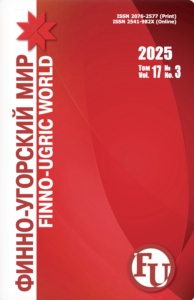DOI: 10.15507/2076-2577.012.2020.03.250-258
Features of acquiring a foreign language (Finnish, Hungarian) by bilinguals
Natalya M. Mosina,
Doctor of Philology, Professor, Department of Finno-Ugric Philology,
National Research Mordovia State University
(Saransk, Russia), natamish@rambler.ru
Nina V. Kazaeva,
Candidate Sc. {Philology}, Associate Professor,
Department of Finno-Ugric Philology,
National Research Mordovia State University
(Saransk, Russia), nikazaeva@yandex.ru
Svetlana V. Batina,
Post-graduate student,
National Research Mordovia State University
(Saransk, Russia), sool15@yandex.ru
Introduction. The article examines the problems arising in the acquisition of Finnish and Hungarian as a foreign language among students who are native speakers of the Mordovian (Moksha or Erzya) and Russian languages, i.e. bilinguals. The work examines the types of bilingualism, identifies the criteria underlying them. The purpose of the article is to identify the nature and causes of the appearance of linguistic features, cases of the manifestation of interference at the level of morphology which further indicate the methods and ways of resolving the emerging difficulties of mastering a foreign language.
Materials and Methods. The factual material was obtained as a result of many years of educational and pedagogical activity in the classroom in the Hungarian and Finnish languages with students of the Philological Faculty of National Research Mordovian State University majoring in “Philology”, track “Foreign philology: Hungarian / Finnish, English languages and literature”. The main research methods are theoretical (the study of scientific and methodological literature on the problem under study), comparative (in the analysis of the morphological system of the Hungarian / Finnish and Mordovian languages), as well as the methods of generalization and observation, widely used for this kind of research.
Results and Discussion. In the article, as a result of the study, the types of bilingualism are presented, the criteria for identifying the types of bilingualism, based on the existing classifications, are determined, the type of Mordovian-Russian bilingualism of the students of the studied group is determined. In the course of the analysis, it was found that when studying the morphological system of the Finnish and Hungarian languages in the written and oral speech of bilingual students, the influence of both the native (Erzyan / Mokshan) and Russian languages (when mastering some local cases, conditional, etc.) is observed. The presented examples are proof of the manifestation of interference, which appears at different linguistic levels.
Conclusion. In the course of the study it was revealed that basically all bilinguals we studied exhibit a contact type of bilingualism, when communication is constantly maintained with speakers of both their native (Moksha or Erzya) and the Russian languages. The recorded phenomena of interference indicate the influence of grammatical systems of non-native (Russian) and native (Erzyan / Mokshan) languages in mastering some morphological structures of Hungarian and Finnish languages by bilingual students. In conclusion, it is concluded that it is impossible to avoid the phenomena of interference in the process of teaching a foreign language at the first stages of learning. The revealed mistakes made by the students make it possible to determine the methods and develop a set of tasks aimed at the perception of a specific foreign language material without using the native language.
Key words: bilingualism; Mordovian-Russian bilingualism; interference; Mordovian languages; Finnish; Hungarian.
For citation: Mosina NM, Kazaeva NV, Batina SV. Features of acquiring a foreign language (Finnish, Hungarian) by bilinguals. Finno-ugorskii mir = Finno-Ugric World. 2020; 12; 3: 250–258. (In Russian)






















